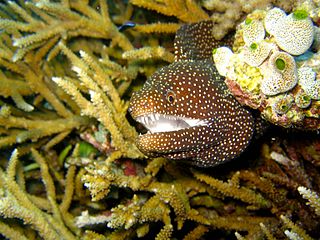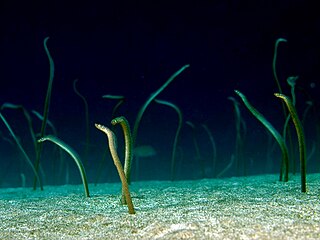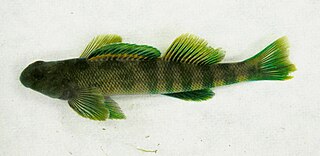
The ornate chorus frog is a species of chorus frog endemic to the Southeastern United States. Their distribution ranges from North Carolina, east to the very eastern part of Louisiana, and south to northern parts of Florida.

The Garibaldi, known historically also as the Catalina goldfish and marine goldfish and now commonly as the Garibaldi damselfish is a species of bright orange fish in the damselfish family. It occurs in the subtropical northeastern part of the Pacific Ocean. The Garibaldi is the official marine state fish of California, as of 1955, and has since been protected in California coastal waters from recreation and commercial fishing.;

Moray eels, or Muraenidae, are a family of eels whose members are found worldwide. There are approximately 200 species in 15 genera which are almost exclusively marine, but several species are regularly seen in brackish water, and a few are found in fresh water.

The Anguillidae are a family of ray-finned fish that contains the freshwater eels. All the extant species and six subspecies in this family are in the genus Anguilla, and are elongated fish of snake-like bodies, with long dorsal, caudal and anal fins forming a continuous fringe. They are catadromous, spending their adult lives in freshwater, but migrating to the ocean to spawn.

The Atlantic silverside, also known as spearing in the northeastern United States, is a small species of fish that is one of the most abundant fish species present in estuarine habitats along the Atlantic coast of North America. It is a common subject of scientific research because of its sensitivity to environmental changes. According to the IUCN Red List, this species is stable and has no major threats to its populations, so it is marked Least Concern. Despite being an extremely common species, most individuals die after one year once they migrate offshore, but a few will make it to two years. The fish is mostly translucent, with white coloring on the anterior end of the body and brown speckling on the top of the head, posterior scales on the back, and near the jaw. A distinctive silver band runs the length of the fish, next to the lateral line. Their mouths are large compared to other Menidia species, and their first dorsal fin are placed more posteriorly than other silversides.

Heteroconger is a genus of marine congrid eels. These small, slender garden eels live in groups where each individual has its own burrow. Usually, only the head and front half of the body is visible. The greatest species richness is in the Indo-Pacific, but species are also found in the warmer parts of the Atlantic and the eastern Pacific. Its name relates to how a huge colony of the eels looks swaying in the current.

The spotted garden eel is a species of heteroconger belonging to the family Congridae. It is native to the Indo-Pacific.

Gorgasia preclara, the splendid garden eel or orange-barred garden eel, is a species of marine garden eel.

Tandanus is a genus of eeltail catfishes endemic to Australia.
The plains minnow is one of the 324 fish species found in central United States. It is a large minnow that was once a common bait fish. The plains minnow requires shallow, slow-moving streams to complete its life cycle. Pollution, dams, and introduced sport fish have caused populations to decline.

The garden eels are the subfamily Heterocongrinae in the conger eel family Congridae. The majority of the 36 known species of garden eels live in the Indo-Pacific, but can be found in warm ocean water worldwide. These small eels live in burrows on the sea floor and get their name from the behavior of poking their heads from their burrows while most of their bodies remain hidden. Since they tend to live in groups, the many eel heads "growing" from the sea floor resemble the plants in a garden. They vary in color and size depending on the species. The largest species reaches about 120 cm (47 in) in length, but most species do not surpass 60 cm (24 in). Garden eel colonies can grow as large as one acre in surface area and number up to several thousand individuals.
Derilissus is a genus of clingfishes belonging to the family Gobiesocinae found in the western Atlantic Ocean. This family of fish is identified by their appearance as small fish with sucking discs which allow them to attach themselves to various surfaces. Derilissus differs from other genera due to its attached gill membranes.

The Barnes' garden eel is an eel in the family Congridae. It was described by Bruce H. Robison and Thomas M. Lancraft in 1984. It is a marine, tropical eel which is known from the western Pacific Ocean, including Indonesia, the Philippines, Vanuatu, the Solomon Islands and Papua New Guinea. It dwells at a depth range of 5 to 20 metres, and inhabits sand substrates. Males can reach a maximum total length of 121 centimetres (48 in).

The Hawaiian garden eel is an eel in the family Congridae. It was described by John Ernest Randall and James Robert Chess in 1980. It is a marine, tropical eel which is known from the Hawaiian archipelago, in the eastern central Pacific Ocean. It is non-migratory, and is thought to be restricted to the region. It dwells at a depth range of 11 to 53 metres, and leads a benthic life, forming burrows in sand. Males can reach a maximum standard length of 59.8 centimetres (23.5 in).
Gorgasia naeocepaea, the freckled garden eel, is an eel in the family Congridae. It was described by James Erwin Böhlke in 1951, originally under the genus Taenioconger. It is a marine, tropical eel which is known from the western central Pacific Ocean, including the Philippines and Indonesia. It is known to inhabit sandy regions, and dwells at a depth range of 10 to 24 metres. Males can reach a maximum total length of 75 centimetres (30 in).
Gorgasia thamani is an eel in the family Congridae. It was described by David Wayne Greenfield and Sean Niesz in 2004. It is a marine, tropical eel which is known from Fiji, in the western central Pacific Ocean. It is known to dwell at a depth range of 14 to 15 metres. Males can reach a maximum total length of 119 centimetres (47 in).
The Galapagos garden eel is an eel in the family Congridae. It was described by Irenäus Eibl-Eibesfeldt and Friedmann Köster in 1983, originally under the genus Taenioconger. It is a marine, tropical eel which is known from the eastern central and southeastern Pacific Ocean, including Colombia, Costa Rica, the Galapagos Islands in Ecuador, and Panama. It dwells at a depth of 10 to 30 m, and lives in large, nonmigratory colonies in clean, sandy substrates. Males can reach a maximum total length of 70 cm.

Taylor's garden-eel is a heteroconger belonging to the family Congridae. It is native to the central Indo-Pacific.

Etheostomatinae is a species-rich subfamily of freshwater ray-finned fish, the members of which are commonly known as the darters. The subfamily is part of the family Percidae which also includes the perches, ruffes and pikeperches. The family is endemic to North America. It consists of three to five different genera and well over 200 species. A common name for these fish in southern Indiana is pollywog.
Erik Bertelsen was a Danish ichthyologist, who specialised in deep sea fish. The fish, Diaphus bertelseniNafpaktitis, 1966 is named in his honour.

















